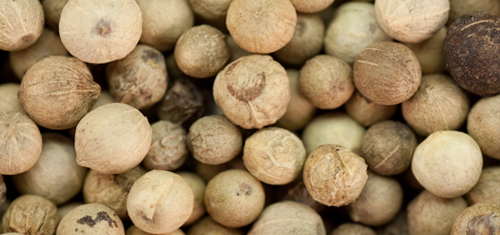White Pepper
White Pepper
Pronounced: pep·ər

White pepper is a slightly milder version of the common black pod or grind. They both originate from the same berries, which are called peppercorns. White peppercorns are smaller, have a smoother skin and a light-tan color with a milder flavor. To reach the white pepper stage, berries are allowed to ripen and then soaked in water to remove the hulls. Black pepper, on the other hand, is harvested before the berries are ripe.
What Is White Pepper?
 White pepper consists of the seed of the pepper plant alone, with the darker-coloured skin of the pepper fruit removed. This is usually accomplished by a process known asretting, where fully ripe red pepper berries are soaked in water for about a week, during which the flesh of the pepper softens and decomposes. Rubbing then removes what remains of the fruit, and the naked seed is dried. Sometimes alternative processes are used for removing the outer pepper from the seed, including removing the outer layer through mechanical, chemical or biological methods.
White pepper consists of the seed of the pepper plant alone, with the darker-coloured skin of the pepper fruit removed. This is usually accomplished by a process known asretting, where fully ripe red pepper berries are soaked in water for about a week, during which the flesh of the pepper softens and decomposes. Rubbing then removes what remains of the fruit, and the naked seed is dried. Sometimes alternative processes are used for removing the outer pepper from the seed, including removing the outer layer through mechanical, chemical or biological methods.
Plant and Cultivation
Often peasants harvest it in the same period of pepper bound to become black. Pepper grows in hot, humid conditions near sea level. The traditional process consists in the immersion of fresh pepper in water for a period of about a week. During this time, there is natural enzymatic process and fermentation phenomena which alter the taste and smell of pepper; this characteristic aroma makes it unique. Next step, pepper is peeled by a gentle rubbing- the pericarp is nearly completely detached by maceration- and finally put lying on the ground for drying in the sun. There are also chemical, mechanical and biological agents methods to decompose pulp from the seed. The difference between the price of black pepper and white pepper is explained by the 30% of yield for the production of white pepper, against 70% yield for the production of black pepper, which is why it costs a bit more. White peppercorns have an earthy flavor whereas black peppercorns simply give heat to a dish. White pepper are processed in the factory by cleaning, grinding, and packaging. Blowers and gravity separators are used to remove dust, dirt clods, bits of twigs and stalk, and other impurities from the peppercorns after they are imported from the field. Sometimes, treatments are used to eliminate bacteria on the cleaned, dry peppercorns.
Description
White pepper starts out the same as the black, but are allowed to ripen more fully on the vine. The outer shell is then removed by soaking the berries in water until the shell falls off, or are held under flowing spring water, yielding a whiter, cleaner pepper. White pepper contains slightly less essential oil than black pepper. The aroma of both black and white pepepr is due to the 80% content of monoterpenes: sabinene, beta-pinene, limonene, furthermore terpinene, alpha-pinene, myrcene, delta-3-carene and monoterpene derivatives (borneol, carvone, carvacrol, 1,8-cineol, linalool). Sesquiterpenes make up about 20% of the essential oil: beta-caryophyllene, humulene, beta-bisabolone and caryophyllene ketone.
Producing Countries of White Pepper
Over the last 20 years pepper exports have increased from 76,816 tons to 197,447 tons recording an annual growth rate of 5%. Today, Vietnam is actually the world’s largest producer and exporter of pepper, accounting for 34%, while India now provides 19% of this spice. It’s interesting to think that pepper was once currency and now pepper and pepper grinders are items found in just about every home. Over the last few years, Vietnam has overtaken the traditional pepper producing countries such as India and Indonesia and added considerable to world pepper production.
Consuming Countries of White Pepper
United States is the number one importer of pepper in the world. United States imported more pepper than any one country exported. United States bought a total of 18% of the world’s pepper in 2009. The next largest buyer of pepper was Germany, who bought less than half that of the United States.
